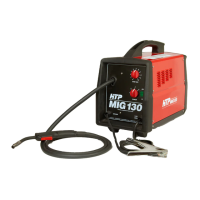8
• Do not use a cylinder or its contents for
anything other than its intended use. Do
not use as a support or roller.
• Do not locate cylinders in passageways or
work area where they may be struck.
• Do not use a wrench or hammer to open
a cylinder valve that cannot be opened by
hand. Notify your supplier.
• Do not modify or exchange gas cylinder
fittings.
• Do not deface or alter name, number or
other markings on a cylinder. Do not rely
on cylinder color to identify the contents.
• Do not connect a regulator to a cylinder
containing gas other than that for which
the regulator was designed.
• Do not attempt to make regulator repairs.
Send faulty regulators to manufacturer’s
designated repair center for repair.
• Do not attempt to lubricate a regulator.
• Always change cylinders carefully to pre-
vent leaks and damage to their walls,
valves, or safety devices.
• Always secure cylinders with a steel chain
so that they cannot be knocked over.
• Always protect a cylinder, especially the
valve, from bumps, falls, falling objects
and weather. Remember that gasses in
the cylinders are under pressure and
damage to a regulator can cause the reg-
ulator or portion of the regulator to be
explosively ejected from the cylinder.
• Always make certain the cylinder cap is
securely in place on the cylinder, whenev-
er the cylinder is moved.
• Always close the cylinder valve and
immediately remove a faulty regulator
from service, for repair, if any of the fol-
lowing conditions exist.
• Gas leaks externally.
• Delivery pressure continues to rise with
down stream valve closed.
• The gauge pointer does not move off the
stop pin when pressurized or fails to return
to the stop pin after pressure is released.
WARNING
This product contains chemicals, including
lead, or otherwise produces chemicals known
to the State of California to cause cancer,
birth defects and other reproductive harm.
Wash hands after Handling. (California
Health & Safety Code Sec. 25249.5 et seq.)
ADDITIONAL SAFETY INFORMATION
For additional information concerning weld-
ing safety, refer to the following standards
and comply with them as applicable.
• ANSI Standard Z49.1 – SAFETY IN WELD-
ING AND CUTTING – obtainable from the
American Welding Society, 550 NW Le
Jeune Road, Miami, FL 33126 Telephone
(800) 443-9353, Fax (305) 443-7559 –
www.amweld.org or www.aws.org
• ANSI Standard Z87.1 – SAFE PRACTICE
FOR OCCUPATION AND EDUCATIONAL
EYE AND FACE PROTECTION – obtainable
from the American National Standards
Institute, 11 West 42nd St., New York, NY
10036 Telephone (212) 642-4900,
Fax (212) 398-0023 – www.ansi.org
• NFPA Standard 51B – CUTTING AND
WELDING PROCESS – obtainable from the
National Fire Protection Association, 1
Batterymarch Park, P.O. Box 9101, Quincy,
MA 02269-9101 Telephone (617) 770-
3000
Fax (617) 770-0700 – www.nfpa.org
• OSHA Standard 29 CFR, Part 1910,
Subpart Q., WELDING, CUTTING AND
BRAZING – obtainable from your state
OSHA office or U.S. Dept. of Labor OSHA,
Office of Public Affairs, Room N3647, 200
Constitution Ave., Washington, DC 20210
– www.osha.gov
• CSA Standard W117.2 – Code for SAFETY
IN WELDING AND CUTTING. – obtainable
from Canadian Standards Association, 178
Rexdale Blvd., Etobicoke, Ontario M9W
1R3 – www.csa.ca
• American Welding Society Standard A6.0.
WELDING AND CUTTING CONTAINERS
WHICH HAVE HELD COMBUSTIBLES. –
obtainable from the American Welding
Society, 550 NW Le Jeune Road, Miami, FL
33126 Telephone (800) 443-9353, Fax
(305) 443-7559 – www.amweld.org or
www.aws.org

